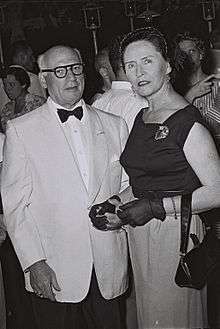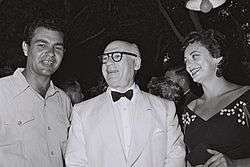Sol Hurok
| Sol Hurok | |
|---|---|
 Sol Hurok with actress Hanna Rovina (1954) | |
| Native name | Соломон Израилевич Гурков |
| Born |
Solomon Izrailevich Gurkov April 9, 1888 Pogar, Chernigov Governorate, Russian Empire |
| Died |
March 5, 1974 (aged 85) New York City, United States |
| Occupation | Impresario |

Sol Hurok (Solomon Isaievich Hurok; born Solomon Izrailevich Gurkov, Russian Соломон Израилевич Гурков; April 9, 1888 – March 5, 1974) was a 20th-century American impresario.[1]
Biography
Hurok was born in Pogar, Chernigov Governorate, Russian Empire (in present-day Bryansk Oblast, Russia) in 1888, and moved to the United States in 1906, becoming a naturalized citizen in 1914.
During Hurok's long career,[2][3] S. Hurok Presents managed many performing artists, including Marian Anderson, Irina Arkhipova, Vladimir Ashkenazy, Feodor Chaliapin, Van Cliburn, Isadora Duncan, Michel Fokine, Margot Fonteyn, Emil Gilels, Horacio Gutiérrez, Daniel Heifetz, Jerome Hines, Isa Kremer, Arturo Benedetti Michelangeli, David Oistrakh, Anna Pavlova, Jan Peerce, Andrés Segovia, Sviatoslav Richter, Mstislav Rostropovich, Arthur Rubinstein, Isaac Stern, Galina Vishnevskaya, Efrem Zimbalist, and many others.
In 1935, Rubinstein introduced Hurok to singer Marian Anderson,[4][5] who retained Hurok as her manager for the rest of her career.[6] A few years later, with Walter White of the NAACP and First Lady Eleanor Roosevelt, Hurok was instrumental in persuading U.S. Secretary of the Interior Harold L. Ickes to arrange Anderson's Easter Sunday open-air concert on the steps of the Lincoln Memorial on April 9, 1939.
Beginning in the late 1930s Hurok managed Colonel W. de Basil's Original Ballet Russe, as well as its offshoot rival company, René Blum's Ballet Russe de Monte Carlo. The Ballet Russe de Monte Carlo and the Original Ballet Russe often performed near each other, for instance in London and New York City. Hurok hoped to reunite the companies, but ultimately was unsuccessful.
In 1959, after 35 years of effort,[7] Sol Hurok brought the historic Russian Bolshoi Ballet to the United States for an eight-week performance tour. In 1961, he brought Russia's Kirov Academy of Ballet and the Igor Moiseyev Ballet Company to the U.S. In 1962, he again brought the Bolshoi to the U.S. for a tour at the height of the Cuban Missile Crisis.[4][8]
The First Moog Quartet, the first to perform electronic music in Carnegie Hall, was formed in 1970 in response to Hurok's request to hear the Moog synthesizer in a live concert.
In honor of Hurok's influence on American music, on December 4, 1971, he was awarded the University of Pennsylvania Glee Club Award of Merit.[9] Beginning in 1964, this award was "established to bring a declaration of appreciation to an individual each year that has made a significant contribution to the world of music and helped to create a climate in which our talents may find valid expression."
In 1972, a bomb planted in Hurok's Manhattan office exploded,[8][10] killing Iris Kones and injuring several others, including Hurok. While many people believe the bombing had been arranged by the Jewish Defense League, which opposed the U.S. tours of artists from the Soviet Union,[11] no one was ever convicted of the crime.
Death
In 1974, en route to a meeting with David Rockefeller to discuss a Rudolf Nureyev project,[8] Hurok died of a heart attack. More than two thousand people nearly filled Carnegie Hall for his funeral,[8] where Marian Anderson delivered the final eulogy.[4]
"He didn't have the musical understanding of a scholar or specialist," Russian pianist Alexander Slobodyanik, another Hurok discovery, told me. "But he had a sixth sense for the aura surrounding an artist, the aura of success or the ability to interest an audience. And after all, most people in a concert audience don't have any special education either. Like Hurok, they just have hearts."
References
- ↑ Harris Green (September 1994). "Book Review: The Last Impresario: The Life, Times, and Legacy of Sol Hurok, by Harlow Robinson". Dance Magazine.
- ↑ S. Hurok at the Internet Broadway Database
- ↑ Sol Hurok at the Internet Movie Database
- 1 2 3 "Brief notes about Sol Hurok".
Fittingly, it was Anderson who said the final words at Hurok's funeral.
- ↑ United States Postal Service (2005). "Marian Anderson, Voice of the Century" (plain text).
- ↑ "Marian Anderson Biography". University of Pennsylvania Library Special Collections-MA Register 4 (Scope and Content Note). January 31, 2003. External link in
|work=(help) - ↑ "What Sol Wrought". Time. April 27, 1959.
After 35 years of trying, Hurok had finally signed Moscow's famed Bolshoi Ballet for an epochal eight-week U.S. tour, and now he was issuing a frantic order: tell newspapers nothing more about the Bolshoi—not even its repertory. Was Hurok mad? Not at all. As the Bolshoi opened at Manhattan's Metropolitan Opera House ... he was merely the center of the fiercest ticket crush in recent memory.
- 1 2 3 4 Harlow Robinson (November 1994). "Sol Hurok: America's dance impresario". Dance Magazine.
By bringing Soviet artists to the West and American artists to the USSR from the mid-1950s through the mid-1970s, Hurok added an important measure of continuity and humanity to the fragile superpower relationship. Even at the height of the Cuban Missile Crisis, the moment at which the world came closest to nuclear war, the Bolshoi Ballet was dancing across the United States under the "S. Hurok Presents" banner. To those opposed to rapprochement with Moscow, however, such as the militant Jewish Defense League, Hurok's presentation of Soviet performers in the United States was a moral outrage. Beginning with picket lines and stinkbombs, the JDL's anti-Hurok campaign climaxed in the terrorist bombing of his offices in early 1972. Hurok was hospitalized for smoke inhalation, and one of his secretaries was killed. Those who knew Hurok well agree that the incident undermined his seemingly indestructible constitution. He died two years later of a massive heart attack on the way to a meeting with David Rockefeller. They were planning to discuss possible financing for a new attraction he was developing with Rudolf Nureyev—"Nureyev and Friends."
- ↑ "The University of Pennsylvania Glee Club Award of Merit Recipients".
- ↑ Richard Rosenthal (2000). "Chapter One, excerpt: Rookie Cop: Deep Undercover in the Jewish Defense League". Leapfrog Press. ISBN 0-9654578-8-5.
Before those responsible were aware they had killed a young Jewish woman, one of those in charge of the operation had already made the obligatory call to the media, saying: "This culture destroys millions of Jews. Cultural bridges of friendship will not be built over the bodies of Soviet Jews. NEVER AGAIN!"
- ↑ Harvey W. Kushner, Encyclopedia of Terrorism, SAGE, 2003, 192–193 ISBN 0-7619-2408-6
- ↑ Harlow Robinson (November 1994). "Sol Hurok: America's dance impresario". Dance Magazine.
|